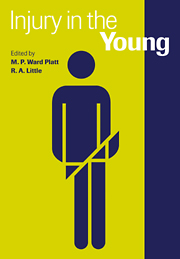Book contents
- Frontmatter
- Contents
- List of contributors
- Editors' Preface
- 1 The epidemiology of trauma involving children
- 2 Emergency room requirements for children
- 3 Child deaths in Accident and Emergency
- 4 Immediate life support
- 5 Evaluation of injury in children
- 6 Injuries of the developing brain
- 7 Wound healing in children
- 8 The lung after injury in children
- 9 Metabolic and endocrine stress responses to surgery
- 10 Head injury in children
- 11 Near drowning
- 12 The acute response to burn injury in children
- 13 Nutritional support of the severely burned child
- 14 Recovery, rehabilitation and the neuropsychological sequelae of head injury
- 15 Children's rights and child protection
- Index
10 - Head injury in children
Published online by Cambridge University Press: 18 September 2009
- Frontmatter
- Contents
- List of contributors
- Editors' Preface
- 1 The epidemiology of trauma involving children
- 2 Emergency room requirements for children
- 3 Child deaths in Accident and Emergency
- 4 Immediate life support
- 5 Evaluation of injury in children
- 6 Injuries of the developing brain
- 7 Wound healing in children
- 8 The lung after injury in children
- 9 Metabolic and endocrine stress responses to surgery
- 10 Head injury in children
- 11 Near drowning
- 12 The acute response to burn injury in children
- 13 Nutritional support of the severely burned child
- 14 Recovery, rehabilitation and the neuropsychological sequelae of head injury
- 15 Children's rights and child protection
- Index
Summary
Importance of head injury
Head injury is the major single cause of mortality and acquired neurological morbidity among children in developed countries. It has important consequences not only for the injured children and their families but also for society as seriously brain injured children who survive represent a significant financial burden on health, education and social service budgets.
In North America, a population-based study by Kraus et al. (1986) found that 10 per 100,000 children aged between 1 and 14 years die each year as a result of trauma to the head. In the UK, the annual mortality rate from head injury in children aged over 1 year is 5.3 per 100,000 children (Sharpies et al., 1990a). The mortality rate from childhood head injury increases with age, head injury accounting for 15% of all deaths among children aged 1–15 years and 25% of all deaths aged 5–15 years. Boys are twice as likely as girls to sustain a fatal head injury.
Head injuries also account for a considerable proportion of paediatric admissions to hospital. The North American National Head and Spincal Cord Survey found the incidence of children aged 0–14 years admitted to hospital for head injury to be 230 per 100,000 children (Kalsbeek et al., 1980), while in California, Kraus et al. (1986) reported a paediatric admission rate for head injury of 185 per 100,000 children.
- Type
- Chapter
- Information
- Injury in the Young , pp. 151 - 175Publisher: Cambridge University PressPrint publication year: 1998
- 4
- Cited by



